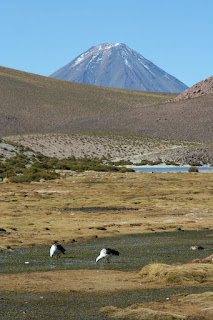We left San Pedro under cover of darkness at 5:45 and made the 100km journey by bus to the highest point. Dawn was just breaking as we arrived and ventured onto the wide plateau surrounded by volcanic peaks. The air temperature at this time was -10°C, which showed in the ice-covered ground, but the magma-heated water under the surface had reached 86°C and was ready to burst forth.
 |
| Field of geysers |
With such a difference in temperature above and beneath the earth, plumes of steam erupted periodically from weak points in the crust, filling the air with clouds of hot gas. Where the pressure had not built sufficiently for such a dramatic display, boiling water bubbled and spurted from fissures coloured red, yellow and green by the high concentration of minerals.
 |
| Colourful |
As the sun lit the peaks and (albeit slightly) warmed the air, the geysers' activity slowed and our driver prepared breakfast.
 |
| First light: breakfast is served |
To the background of the still fizzing and hissing geysers, we noshed hungrily on perfectly scrambled eggs, cheese, bread, and cake with jam and cream cheese.
 |
| An army of furry creatures march on the geysers |
Still feeling the chill in my fingers, despite wrapping them around a hot cup of tea, I was pleased to hear that we would next be paying a visit to a natural hot water spring.
 |
| Not so hot water baths |
This promised to warm our bones with 30°C water, but in practice the heat was patchy, seemingly originating from a corner of the pool at an unbearably hot temperature and mixing quickly with chilled water to make a tepid bath.
 |
| He didn't get out quickly enough |
Having shivered back into our clothes, we sat aboard the warm bus for a safari of the indigenous wildlife that lives at this altitude.
 |
| Vicuñas |
Most apparent are groups of graceful vicuñas. Looking like a cross between a camel and a deer, these animals have the long necks of the former, but the elegance of the latter.
Another animal native to this region but not as obvious as the vicuña, is the viscacha - a rabbit-like rodent that hides amongst rocks and has powerful hind legs, like a kangaroo, and a long tail.
 |
| It's a puppet |
The Putana river flows in the shadow of the active and constantly smoking volcano of the same name. On its waters we saw dozens of dark taguas gigantes (giant coots) and black-and-white gansos andinos (Andean geese).
 |
| A pair of Andean geese |
Also in evidence were woolly llamas, wearing their distinctive colourful earrings.
 |
| Llamas |
On the way back down to San Pedro, we stopped at a small remote village called Machuca, which is entirely populated by local atacameños. However, being so remote, the families commute to a larger village during school term, so the houses were mostly empty, save for a few empanada sellers to serve the tourists.
 |
| Machuca village church |
A bizarred occurrence interrupted our return journey. Suddenly, the music, which had been playing in the background on the bus, stopped. Expecting engine trouble, I was surprised when the driver removed the keys from the ignition and the vehicle proceeded to ascend the hill in front of us unaided. The explanation was that a strong magnetic field lay along the road. It was an eerie experience.
 |
| Put the cheese in the pepper |
At home for the afternoon, I filled a red pepper with cheese and courgette, serving it alongside our favourite accompaniments of spicy salsa, guacamole, and rice.
No comments:
Post a Comment